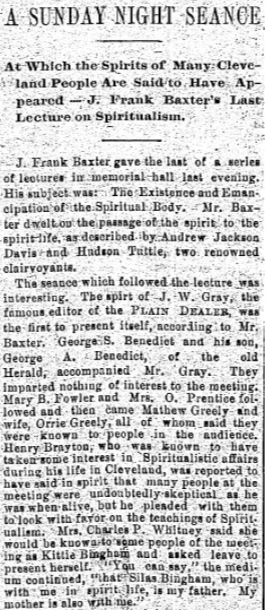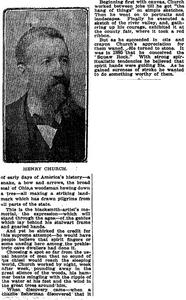Exploring Henry Church, Jr. Rock in South Chagrin Reservation
- Dan Wagner
- Jun 21, 2023
- 4 min read
Updated: Jun 9, 2024
In 1885, Henry Church, Jr., apparently had a story to tell. So, the local blacksmith and self-proclaimed spiritualist spent his evenings with hammer and chisel carving his masterpiece into a massive sandstone boulder along the western bank of the Chagrin River. He titled his work "The Rape of the Indians by the White Man". The relief depicts many figures, including a scantily clad Native American woman, an ten-foot-long snake, a patriotic shield, a quiver of arrows, tomahawk, mountain lion, an eagle with its wings spread, papoose, and more. Ever since, the relief has been a local landmark, drawing tens of thousands of visitors every year.


Trailhead elevation 900'
Water at trailhead
Don't miss the carvings on the river side of the rock and the Native American depiction on the south side
Hiking to Henry Church Rock
The trailhead is situated towards the back of the Henry Church Picnic Area parking lot. For the best hiking experience, follow the trail in a clockwise direction, as described in this article. Starting from the parking area, you will descend a stone staircase, which leads to a clearly marked dirt trail below.

Upon reaching the base of the staircase, you'll find a brief spur trail branching off to the left of the main trail. The spur runs parallel to and eventually beneath Double Decker Falls, a two-tier waterfall measuring eight feet in height that stretches across the breadth of the Chagrin River.

After returning from the detour to the falls, the main trail runs alongside the river upstream for 0.2 miles until it arrives at Henry Church, Jr. Rock. During this stretch you will pass to quaint stone arch bridges adorned with sturdy stone walls. If it has recently rained, you'll be treated to the sight of small cascades flowing over the cliffs to the right, adjacent to each bridge. Right below the second bridge you'll find the unmistakable Henry Church, Jr. Rock.

Previously recognized as Squaw Rock for more than a hundred years, its name was changed to Henry Church, Jr. Rock in response to protests from non-Native Americans who deemed the term "squaw"offensive and derogatory. Interestingly, "squaw" originates from the Algonquin language and signifies "woman," so maybe the protesters were protesting just to protest. Etched along the lower right corner of the rock is the inscription " H. Church 1885," a testament to Church's connection to the formation.

Located slightly above the inscription, you will encounter a papoose, a common baby carrier used by Native Americans, and to the left of the papoose there is a large mountain lion.

Within the grasp of the mountain lion's claws, you'll observe a human head, accompanied by a rib cage to the left. To the left of the mountain lion, there is a depiction of a Native American woman with long, flowing hair and outstretched arms. Enveloping the woman is what appears to be a large rattlesnake, while above it an eagle with its wings spread.

To the left of these depictions, you'll find a tomahawk, a quiver brimming with arrows, a shield adorned with two stars and an eagle, as well as an unidentified carving. Although the rock bears some instances of vandalism, it has managed to maintain its overall excellent condition considering its age.

The river-facing side of the rock showcases several notable depictions, including a pioneer woodsman felling trees, a log cabin, and even the iconic Capitol Building in Washington, D.C., which are believed to narrate the journey of Abraham Lincoln. While this particular side of the rock may be partially concealed by lichen and overgrowth, the images are easy to locate.

Adjacent to the log cabin, you will find the pioneer woodsman, though the passage of time has left its mark on this portion of the rock.

Beyond the rock you will encounter a stone staircase that ascends towards the top of the cliffs, ultimately leading back to the trailhead.

The hike is largely shaded thanks to an abundance of Eastern hemlock trees along the trail, so even on sunny days there is a fair amount of coverage. Throughout the trail you will be treated with gorgeous views, complemented by the soothing sound of the Chagrin River. Near the trailhead, in the picnic area, you find convenient amenities, including bathrooms, picnic tables, and a spacious stone fire pit with wooden Adirondack chairs.
About Henry Church, Jr.
Henry Church, Jr. lived a fascinating life and was often regarded as the most interesting person in Chagrin Falls during his time. A biographical sketch from an 1896 edition of the Cleveland Plain Dealer delves into Church's life, tracing his family's arrival in Chagrin Falls in 1833, when the settlement was still a wilderness inhabited by just two other families. It goes on to detail his occupation as a blacksmith and highlights his extensive artistic endeavors, which encompassed numerous paintings, including portraits of prominent figures such as Shakespeare and Abraham Lincoln, rendered in charcoal, oil, or crayon. The piece also notes the eclectic decor of his home, adorned with Native American artifacts, antique iron tools, remnants from the War of 1812, and intricately carved, self-produced woodwork, before exploring his masterpiece along the banks of the Chagrin River.

Mr. Church proved to be quite an intriguing character, as demonstrated by his readiness to participate in séances. An article from the Plain Dealer dated February 25, 1889, recounts one such occasion where he took part. The séance, conducted by Josiah Francis Baxter, a lecturer and self-professed clairvoyant, allegedly called forth the spirits of various Cleveland residents during the gathering, among them Henry Church, Sr., Church's father.
Henry Church, Jr. departed on April 17, 1908, at the age of 72. A tribute in the Plain Dealer commemorated Church as an artist by impulse and a blacksmith by necessity. It recounted the meticulous dedication he poured into crafting Squaw Rock, and highlighted his distinction as only the second non-Native American born in the Chagrin Falls settlement.
In a somewhat unconventional gesture, before his passing, Church recorded his own funeral sermon on a phonograph. As loved ones gathered to mourn his departure, his voice resonated, expressing gratitude for their kindness throughout his lifetime.

Today, Church's legacy endures through his magnum opus along the Chagrin River, even after nearly a century and a half since its creation. In reverence to him and his family, please refrain from causing any harm to the artwork and allow others to appreciate it for generations to come.
_edited.png)































